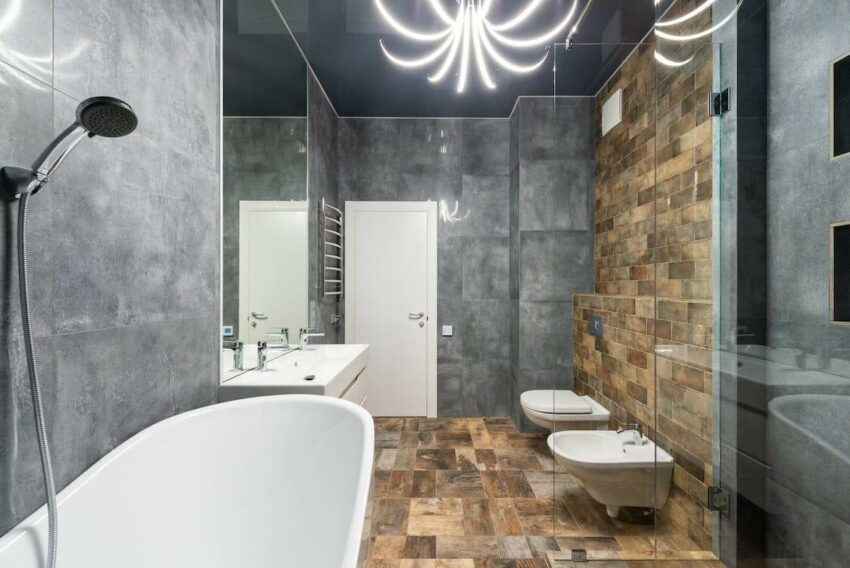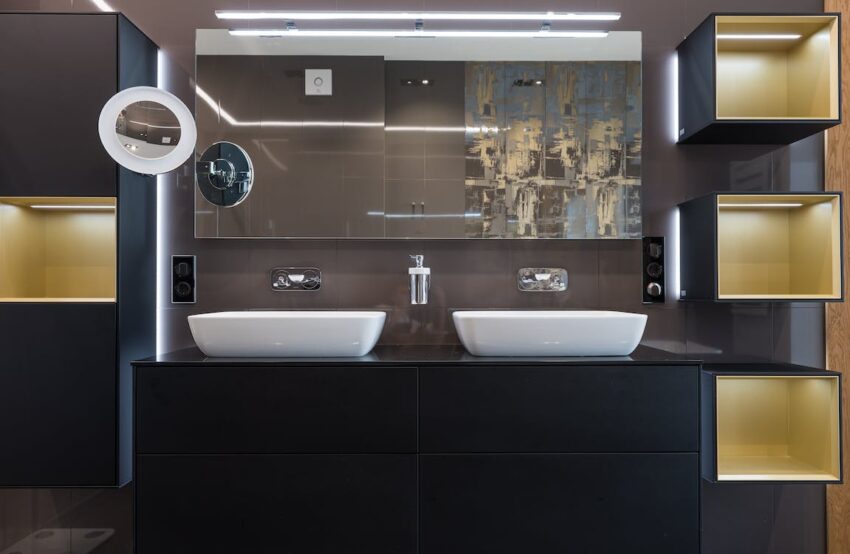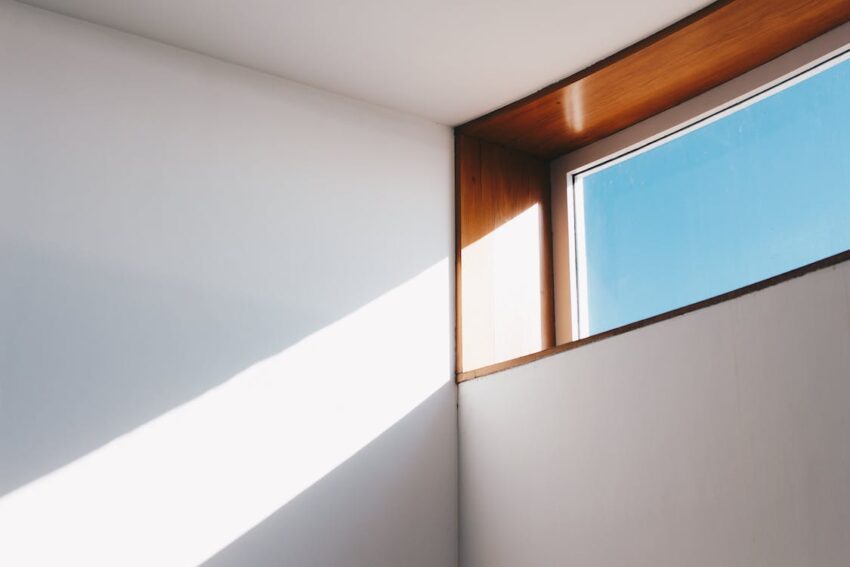“Welcome to the comprehensive Designer’s Guide to Bathroom Windows, where we embark on a journey through the intricacies of creating well-designed and functional bathroom spaces by harnessing the potential of windows.”
Bathroom design is no longer just about functionality; it’s an art form that demands careful consideration of every element. Among these elements, bathroom windows play a crucial role in enhancing the overall ambiance and functionality of the space. The right window design can bring in natural light, provide ventilation, offer privacy, and add a touch of style. In this comprehensive guide, we’ll delve into the various aspects of bathroom window design, exploring different types, placement options, materials, treatments, and more.

Approaches to Bathroom Windows
Bathroom windows are a unique and essential component of interior design that require a delicate balance between aesthetics, functionality, and privacy. As the gateway to natural light, ventilation, and exterior views, bathroom windows play a pivotal role in shaping the ambiance and usability of these intimate spaces. In this exploration of different approaches to bathroom windows, we delve into the diverse options available for incorporating these vital elements into bathroom design. From innovative materials to strategic placement, window treatments, and architectural considerations, this guide offers insights into creating harmonious and practical bathroom environments that cater to both visual appeal and the essential needs of everyday living.
Functionality Comes First with Bathroom Windows
When it comes to bathroom window design, functionality should always be your starting point. Bathrooms require proper ventilation to prevent moisture buildup, which can lead to mold and mildew. Consider the size of the bathroom, its location within the house, and local climate factors. Ventilation can be achieved through various window types such as awning, casement, or hopper windows, which can be opened to let fresh air in while maintaining privacy.
One of the most critical yet often overlooked elements is the functionality of the windows. While windows contribute to the aesthetics of the space, their primary purpose extends far beyond style – they serve a crucial role in ensuring the comfort, health, and overall functionality of the bathroom. In this section, we will delve deeper into the various aspects of bathroom window functionality, highlighting why it matters and how it can be optimized for the best possible user experience.

Ventilation: The Battle Against Moisture
One of the primary functions of bathroom windows is ventilation. Bathrooms are naturally humid environments due to showers, baths, and sinks. Without proper ventilation, this moisture can accumulate, leading to mold, mildew, and deterioration of fixtures. Bathroom windows play a pivotal role in addressing this issue by allowing fresh air to circulate, preventing excessive humidity buildup.
To achieve effective ventilation, consider window types that can be opened, such as awning, casement, or hopper windows. These types are designed to allow air to flow into the bathroom while keeping rainwater out. Properly placed windows can create a cross-ventilation effect, expelling damp air and replacing it with fresh outdoor air.
Natural Light: Illuminating the Space
Natural light is a precious resource that can significantly enhance the aesthetics and functionality of any room, including bathrooms. Adequate lighting makes the space feel larger, more inviting, and more visually appealing. Bathroom windows allow natural light to enter, reducing the need for artificial lighting during the day and creating a more pleasant environment.
To maximize natural light while maintaining privacy, consider options like frosted or textured glass. Skylights are also an excellent choice, especially for bathrooms with limited wall space. The strategic placement of windows can ensure that sunlight reaches all corners of the room, reducing the need for excessive artificial lighting.
Privacy: Balancing Visibility and Seclusion
Privacy is paramount in bathrooms, and achieving the right balance between visibility and seclusion is essential. While windows allow light and ventilation, they must also ensure that individuals using the bathroom are not exposed to the outside world.
To address this concern, various privacy solutions can be employed. Frosted or obscured glass can diffuse the view while still allowing light to pass through. Window films are another option, offering an array of designs that provide privacy while maintaining a visually pleasing appearance. Additionally, well-placed windows that are positioned high on the wall or above eye level can safeguard privacy without compromising functionality.

Aesthetic Enhancement: Complementing Design Elements
Functionality and aesthetics need not be mutually exclusive. In fact, well-designed bathroom windows can enhance the overall visual appeal of the space. The choice of window type, frame color, grille patterns (if applicable), and how they harmonize with other design elements all contribute to the overall atmosphere of the bathroom.
For instance, a strategically placed window can become a focal point, drawing attention to a beautiful view or architectural feature. Choosing window frames that match the bathroom’s color scheme or theme can create a cohesive look. The careful integration of windows into the design ensures that they not only serve their functional purposes but also contribute to the overall ambiance.
Durability: Materials for Longevity
Given the humidity and moisture present in bathrooms, the choice of materials for windows is crucial for long-term functionality. Opt for materials that are moisture-resistant and durable, such as vinyl, fiberglass, or aluminum-clad wood. These materials are less susceptible to warping, rotting, or deteriorating over time due to exposure to moisture.
Bathroom window functionality goes beyond basic ventilation and lighting. It encompasses a thoughtful integration of design and practicality to create a space that is not only visually appealing but also conducive to a healthy and comfortable environment. By understanding the role of windows in promoting ventilation, harnessing natural light, ensuring privacy, and contributing to the overall aesthetic, designers can craft bathrooms that are functional, inviting, and enduringly beautiful.

Natural Light: A Key Ingredient
Natural light can transform any space, making it feel larger, more welcoming, and healthier. However, privacy is a concern in bathrooms. To strike a balance between light and privacy, consider frosted or obscured glass options. Skylights, large picture windows, or windows placed higher on the wall are great alternatives to traditional windows, as they bring in ample natural light without compromising privacy.
Choosing the Right Window Type
Several window types are suitable for bathrooms. Some popular options include:
- Awning Windows: Hinged at the top and open outward, these windows allow for ventilation even during light rain. They’re ideal for ensuring airflow while maintaining privacy.
- Casement Windows: Similar to awning windows, casement windows are hinged on the side and open outward. They provide excellent ventilation and unobstructed views when opened.
- Hopper Windows: These windows are hinged at the bottom and open inward. They’re great for smaller bathrooms and provide controlled ventilation.
- Skylights: Installed on the ceiling, skylights bring in abundant natural light while maintaining privacy. They’re perfect for bathrooms with limited wall space.
- Transom Windows: Placed above eye level, transom windows allow light to flow from one room to another while ensuring privacy.

Materials Matter
Bathroom windows are exposed to high humidity levels, so choosing the right materials is crucial to avoid rot and deterioration. Opt for materials that are moisture-resistant and durable, such as vinyl, fiberglass, or aluminum-clad wood. These materials are less likely to warp or decay over time.
When it comes to designing or renovating a bathroom, selecting the right materials for the windows is a crucial decision. Bathrooms are unique spaces that demand materials capable of withstanding high levels of humidity, temperature fluctuations, and occasional splashes of water. In this guide, we’ll explore various window materials, their advantages, and considerations to help you make an informed choice that aligns with your bathroom design and functional needs.
Vinyl Windows: Durability and Low Maintenance
Vinyl windows have become a popular choice for bathrooms due to their excellent moisture resistance and durability. They are made from PVC (polyvinyl chloride) material, which is inherently moisture-resistant and won’t warp, crack, or peel when exposed to high humidity. Vinyl windows are also known for being low maintenance – they do not require painting or sealing and can be easily cleaned with mild soap and water.
Advantages:
- Excellent moisture resistance
- Low maintenance
- Wide range of styles and colors available
- Energy-efficient options with insulated frames
Considerations:
- Limited customization options compared to wood
- May have a slightly less upscale appearance compared to wood
Fiberglass Windows: Strength and Energy Efficiency
Fiberglass windows are another excellent choice for bathrooms. They are highly durable and can withstand extreme temperature variations without warping or cracking. Fiberglass is non-porous, which makes it resistant to moisture and rot. These windows are also energy-efficient, providing good insulation to keep your bathroom comfortable.
Advantages:
- High durability and resistance to moisture
- Energy-efficient insulation properties
- Can be painted to match your bathroom’s aesthetic
- Minimal expansion and contraction with temperature changes
Considerations:
- Usually more expensive than vinyl
- Limited availability compared to other materials
Aluminum Windows: Sleek and Modern
Aluminum windows offer a sleek and modern look that can complement contemporary bathroom designs. While aluminum itself is not prone to moisture damage, the construction of these windows may involve thermal breaks or barriers to prevent condensation on the inside surface. They are lightweight and resistant to rust, making them suitable for bathrooms.
Advantages:
- Modern and stylish appearance
- Lightweight and resistant to rust
- Can be easily painted to match your bathroom decor
- Low maintenance
Considerations:
- Aluminum is a good conductor of heat, so thermal breaks are necessary for energy efficiency
- May not provide the same level of insulation as other materials
Wood Windows: Timeless Elegance
Wood windows are classic and offer a timeless elegance that can enhance the overall ambiance of your bathroom. While wood is susceptible to moisture damage, modern wood window frames are often treated and sealed to resist moisture. Properly maintained wood windows can provide exceptional beauty and longevity.
Advantages:
- Aesthetically pleasing with a warm and natural appearance
- Can be customized with various stains and finishes
- Good insulation properties
- Long-lasting with proper care and maintenance
Considerations:
- Require regular maintenance to prevent moisture damage
- More prone to warping, cracking, and peeling if not properly maintained
- Generally more expensive than other materials

Composite Windows: Best of Both Worlds
Composite windows combine the benefits of different materials, often featuring a combination of wood, vinyl, or fiberglass. These windows are designed to provide the appearance of wood with the durability and low maintenance of other materials.
Advantages:
- Offers the aesthetic appeal of wood without the drawbacks
- Enhanced durability and moisture resistance
- Low maintenance
- Can be painted or stained to match your bathroom design
Considerations:
- Cost may be higher than individual materials
Selecting the right window materials for your bathroom involves considering factors such as moisture resistance, durability, maintenance requirements, aesthetics, and energy efficiency. Each material comes with its own set of advantages and considerations, so it’s essential to evaluate your priorities and preferences. By choosing windows that are specifically designed for bathroom environments, you can ensure that your windows not only enhance the beauty of your space but also provide lasting functionality.
Privacy Solutions
Privacy is a primary concern in bathroom design. Here are some effective solutions:
- Frosted Glass: Frosted or textured glass obscures the view while allowing light to pass through. It’s available in various patterns to match your aesthetic.
- Window Film: Privacy window film is a cost-effective solution that comes in a variety of designs. It offers privacy while still allowing light to filter through.
- Curtains or Blinds: Fabric curtains or blinds can be adjusted to control visibility and natural light. Choose moisture-resistant materials for longevity.
Aesthetic Considerations
While functionality is paramount, aesthetics also play a crucial role. Coordinate your bathroom window design with the overall style of the space. Consider factors like frame color, grille patterns (if applicable), and how the window complements other design elements like tiles, fixtures, and wall colors.
Placement Strategies
Window placement can greatly impact the functionality and aesthetic appeal of the bathroom. Placing windows strategically can maximize light, maintain privacy, and create focal points. For instance:
- High Windows: Placing windows high on the wall lets in light while maintaining privacy. This works well in bathrooms where you want to preserve wall space for fixtures.
- Corner Windows: Placing a window in the corner can provide ample natural light without compromising privacy. It also adds a unique design element.
- Above-Tub Windows: Installing a window above a bathtub can create a luxurious spa-like feel. Make sure to choose materials and treatments that withstand moisture.

Bathroom Window Design Tips
Designing bathroom windows requires a thoughtful approach that balances aesthetics, functionality, and privacy. Here are some valuable tips to consider when designing bathroom windows:
- Prioritize Privacy:
- Choose window treatments that provide privacy without sacrificing natural light, such as frosted or textured glass, window film, or blinds.
- Consider placing windows higher on the wall or using transom windows to maintain privacy while still allowing light to enter.
- Ventilation is Key:
- Opt for windows that can be opened to facilitate proper ventilation and prevent moisture buildup. Awning, casement, and hopper windows are great choices.
- If possible, position windows strategically to create cross-ventilation and promote airflow.
- Maximize Natural Light:
- Incorporate large windows, skylights, or strategically placed smaller windows to maximize the entry of natural light.
- Use mirrors strategically to reflect and amplify natural light within the space.
- Consider the View:
- Capitalize on pleasing outdoor views by placing windows to frame them. However, ensure that privacy is maintained while doing so.
- Use frosted glass or other privacy solutions when a view is not desirable or practical.
- Choose Moisture-Resistant Materials:
- Opt for window materials that can withstand the bathroom’s humid environment. Vinyl, fiberglass, and aluminum-clad wood are good options.
- Ensure proper sealing and caulking to prevent water infiltration.
- Select Appropriate Window Styles:
- Depending on the bathroom’s layout and design, choose window styles that suit your needs. Awning, casement, hopper, and skylight windows are popular choices.
- Corner windows, if feasible, can offer both ventilation and visual interest.
- Coordinate with Design Elements:
- Choose window frames and finishes that complement the overall bathroom design. Coordinate with fixtures, tiles, and color palette for a cohesive look.
- Consider integrating window grilles or muntins if they align with the design theme.
- Utilize Natural Elements:
- Incorporate plant shelves or decorative ledges beneath windows to bring natural elements into the space.
- Use windows as a backdrop for indoor plants to create a serene and refreshing atmosphere.
- Add a Focal Point:
- Create a focal point by placing a decorative window in a prominent location within the bathroom.
- Consider adding a stained glass or mosaic-style window to infuse artistic flair.
- Incorporate Built-In Storage:
- Design windows with built-in shelving or niches to serve as storage for toiletries or decorative items.
- This can help save space and keep the bathroom organized.
- Embrace Unique Shapes:
- Experiment with unconventional window shapes to add visual interest to the bathroom. Circular, oval, or arched windows can create a unique focal point.
- Mind the Exterior:
- Ensure that exterior elements, such as landscaping, are considered when placing windows. Avoid obstructing views or compromising privacy.
- Use Dimmable Lighting:
- Pair your window design with dimmable lighting fixtures to maintain a cozy ambiance during evenings or nighttime.
- Professional Consultation:
- If unsure about window placement or design, consult a professional designer or architect to ensure optimal functionality and aesthetics.
Incorporating these tips into your bathroom window design will help you create a space that not only looks stunning but also meets your practical needs for ventilation, privacy, and natural light. Remember that the right window design can significantly enhance the overall appeal and comfort of your bathroom.

Bathroom Windows Conclusion
Bathroom window design is a delicate balance between functionality and aesthetics. The right window choice can elevate your bathroom’s atmosphere, making it a more inviting and comfortable space. As you embark on your bathroom design journey, consider the layout, natural light, ventilation needs, privacy concerns, and overall design theme to create a harmonious and functional bathroom with windows that enhance its beauty and practicality.
Looking for more great style and design tips for your bathroom?
- Bathroom Counter Decor Style Guide
- The Best Tips to Organize Your Bathroom Drawers
- Our Favorite Bathroom Flooring Ideas
- The Elegance of Bathroom Vanities
- Styles of Bathroom Backsplashes
- Trends in Bathroom Ceiling Paint
- Stylish Bathroom Chandeliers
- Our Guide to Bathroom Windows
- Interior Decorators Guide to Bathroom Towels
- Our Favorite Bathroom Tiles
- Designers Bathroom Mirror Tips
- Interior Design and Style Bathroom Ideas





























